What Would Happen If You Removed All the Billboards and Ads? These 8 Images Will Show You Surprising Results
Have you ever heard of the term "visual pollution"? It's used to describe the overwhelming amount of artificial elements in cities such as billboards, cables, and other distractions that can negatively affect the aesthetic quality of the environment. While some people might not mind these elements, for others, especially those with sensory sensitivity, they can cause mental health issues like anxiety and depression.
Have you ever wondered what our cities would look like without these distractions? A company called "House Fresh" has edited images of famous locations to show us what these cities could look like if we removed these elements. And let me tell you, the results are pretty stunning! By removing visual noise, cities can become cleaner and more visually appealing. It definitely raises some questions about what we value more: the hustle and bustle of a big city or a more peaceful, aesthetically pleasing environment. What do you think?
More info: Instagram | Twitter | Pinterest | Website
Shibuya Crossing is known for its bright lights and busy atmosphere, like Times Square. But what if we take a more thoughtful approach to the way we design the buildings around the intersection? By reducing light pollution, we could make the area look even better without sacrificing its unique character.
Mong Kok may not look very attractive underneath its bright neon lights, but it's truly amazing. If its stacked living spaces were transformed with a solarpunk makeover or even just a few exterior living walls, it could be a much more pleasant and healthier place to live and shop.
People have been trying to clean up the visual space in LA for many years now. However, some believe that if Hollywood didn't have its glitz and glamour, it would just be an average city. The "image culture" is what makes LA famous, and the billboards along the boulevard range from cheesy symbols to high-quality art.
However, Hollywood Boulevard already has palm trees, beautiful art deco buildings, and stunning sunsets. Do we really need to see tacky ads and movie posters for films we already know about? The street would look even more like paradise without them. Maybe they should even think about making it a pedestrian-only area...
There are some clean-up efforts taking place in Delhi, especially in areas where the phone and power infrastructure has become chaotic and tangled up with the buildings. However, some people see the colorful walls beyond the cables as an art form, suggesting that Delhi's hanging cables are their own unique kind of art.
Because of its special place in American culture, Times Square is at the center of a debate about whether what one person sees as visual pollution is actually just a natural part of modern life for others. Some people even argue that the old Times Square, with its grime and aging billboards, was actually better because it provided a welcoming backdrop for the city's outcasts. However, the new Times Square is often seen as a symbol of the greed and excess of the 1980s, when it was "Disneyfied." Maybe there's a more thoughtful way we can refresh the visual landscape for the mid-21st century.
Cars are often not very attractive, they can be dirty and distract from the surroundings, which creates more visual pollution, like exhaust fumes, reflections, and extra signs. Thankfully, Kampala is doing something about this problem by addressing visual and air pollution. The city has even been designated as Africa's first "Tree City" for its efforts to plant and protect trees in urban areas.
A potential solution could be to find a balance between preserving the city's unique identity and reducing the harmful effects of excessive lighting. Perhaps, a more targeted approach to lighting could still create a vibrant atmosphere without negatively impacting human health or the environment.
Today, there is only one giant sign in the area that has advertising banned from buildings owned by the Crown Estate. Despite this, the area is still known as 'London's Times Square' due to the significance of the location as a junction and entertainment district. The advertising lights were turned off for an hour during the Lights Out London campaign in 2007, but they have only been dimmed during times of war, energy shortages, and national mourning for figures such as Winston Churchill and Diana, Princess of Wales.
Have you ever wondered what our cities would look like without these distractions? A company called "House Fresh" has edited images of famous locations to show us what these cities could look like if we removed these elements. And let me tell you, the results are pretty stunning! By removing visual noise, cities can become cleaner and more visually appealing. It definitely raises some questions about what we value more: the hustle and bustle of a big city or a more peaceful, aesthetically pleasing environment. What do you think?
More info: Instagram | Twitter | Pinterest | Website
#1. Shibuya Crossing, Japan
Capitalism might be tempted to put glowing ads on Shibuya Crossing since there are around 2,500 pedestrians crossing the street at any given time. However, the area around the ancient Uda and Onden rivers is so beautiful that it deserves better than flashing ads.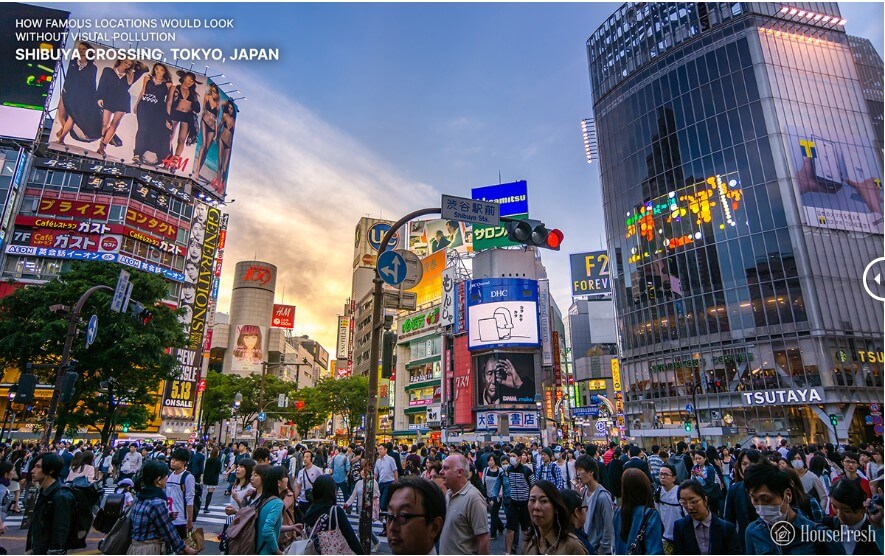 Source: HouseFresh
Source: HouseFresh
Shibuya Crossing is known for its bright lights and busy atmosphere, like Times Square. But what if we take a more thoughtful approach to the way we design the buildings around the intersection? By reducing light pollution, we could make the area look even better without sacrificing its unique character.
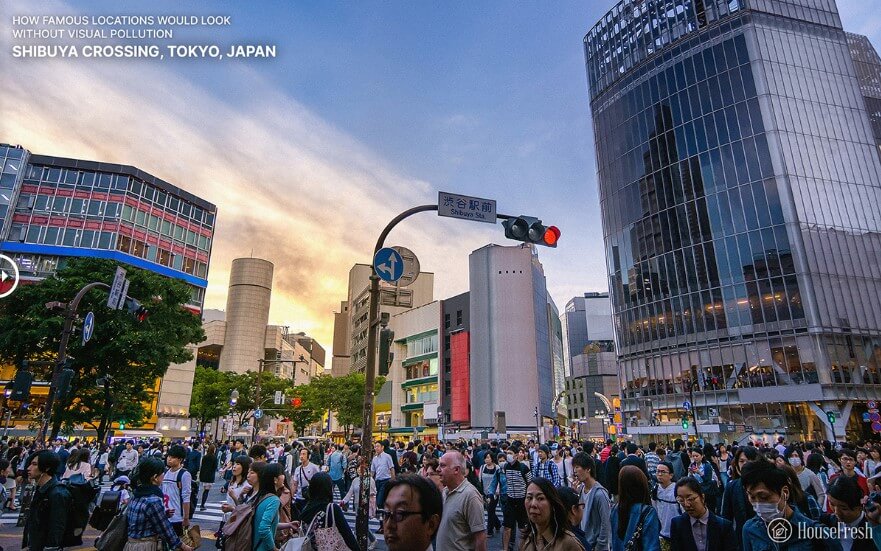 Source: HouseFresh
Source: HouseFresh
#2. Mong Kok District, Hong Kong
Hong Kong's neon signs are important to the city's image and history, but many of these boards are not only distracting but also dangerous because they are illegal structures. With Hong Kong being the world's most densely populated place, merchants in the shopping district of Mong Kok need to use bright lights to get buyers' attention.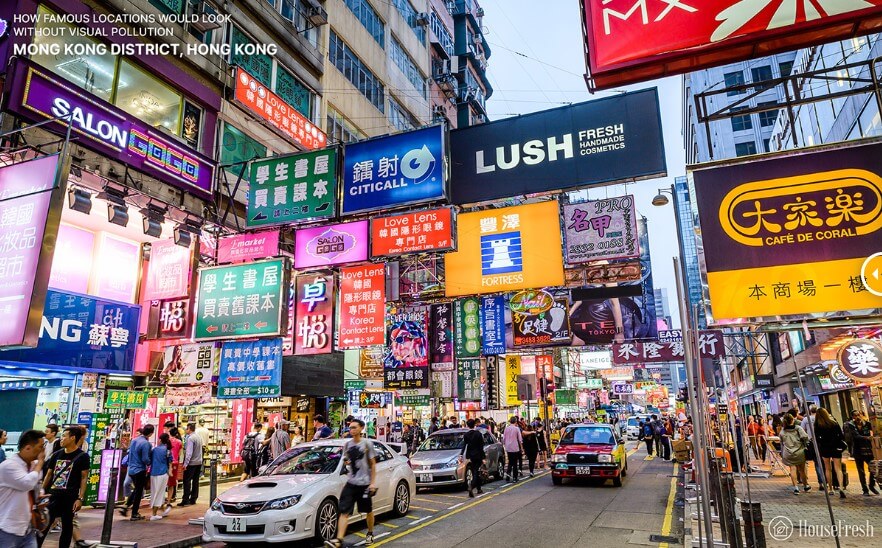 Source: HouseFresh
Source: HouseFresh
Mong Kok may not look very attractive underneath its bright neon lights, but it's truly amazing. If its stacked living spaces were transformed with a solarpunk makeover or even just a few exterior living walls, it could be a much more pleasant and healthier place to live and shop.
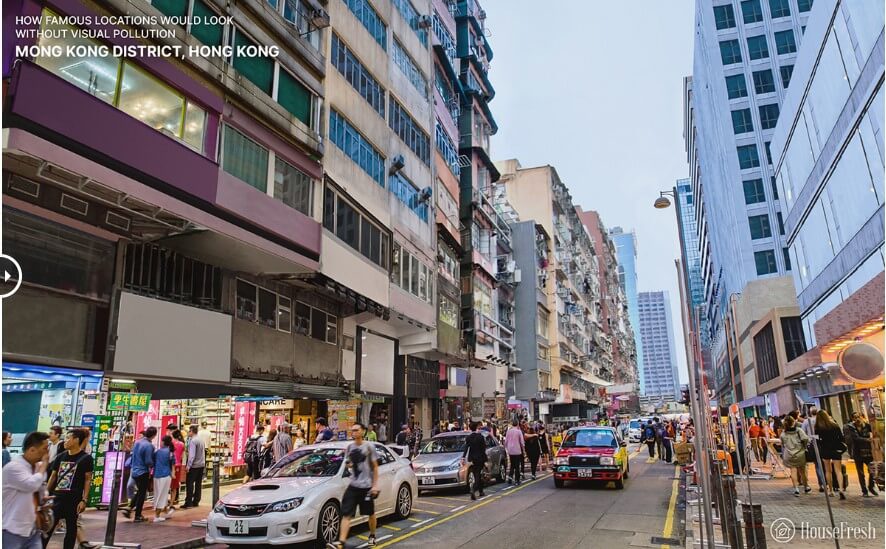 Source: HouseFresh
Source: HouseFresh
#3. Hollywood Boulevard, USA
People have been trying to clean up the visual space in LA for many years now. However, some believe that if Hollywood didn't have its glitz and glamour, it would just be an average city. The "image culture" is what makes LA famous, and the billboards along the boulevard range from cheesy symbols to high-quality art.
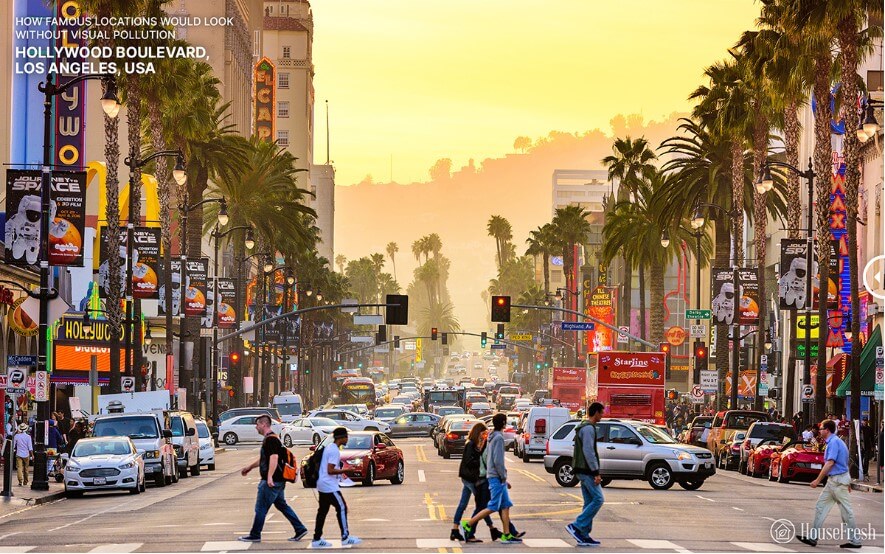 Source: HouseFresh
Source: HouseFresh
However, Hollywood Boulevard already has palm trees, beautiful art deco buildings, and stunning sunsets. Do we really need to see tacky ads and movie posters for films we already know about? The street would look even more like paradise without them. Maybe they should even think about making it a pedestrian-only area...
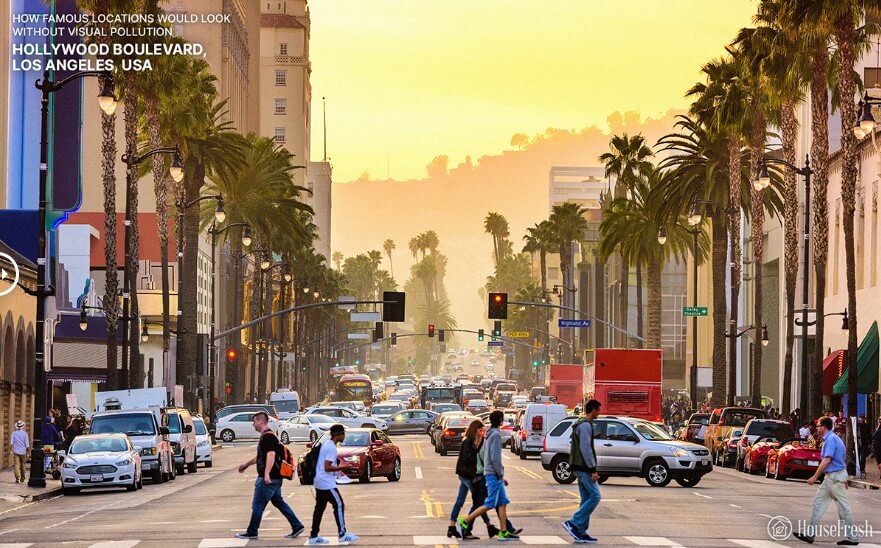 Source: HouseFresh
Source: HouseFresh
#4. Delhi, India
India's capital, Delhi, is filled with visual pollution. The air is filled with dust and smog, and garbage is everywhere. In some neighborhoods, like this one in Old Delhi, there's hardly any space left for big billboards because of all the make-shift wiring and cables. Source: HouseFresh
Source: HouseFresh
There are some clean-up efforts taking place in Delhi, especially in areas where the phone and power infrastructure has become chaotic and tangled up with the buildings. However, some people see the colorful walls beyond the cables as an art form, suggesting that Delhi's hanging cables are their own unique kind of art.
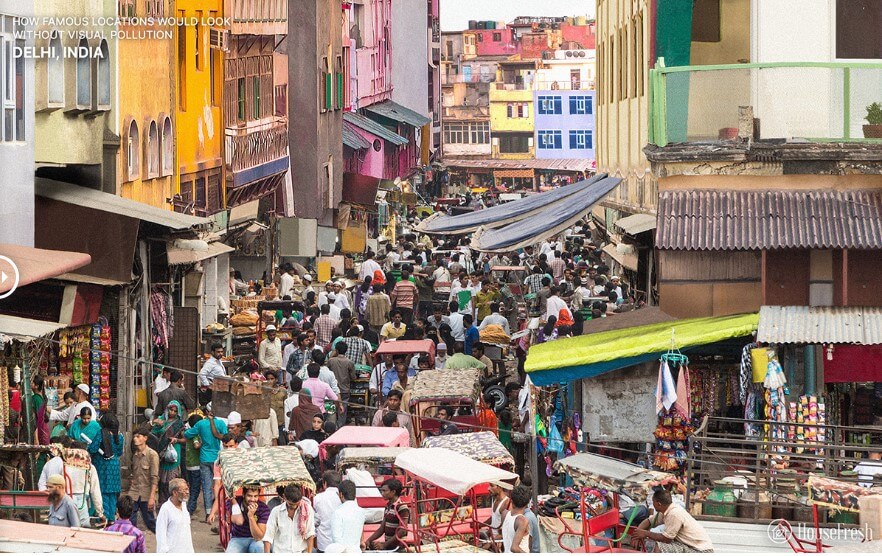 Source: HouseFresh
Source: HouseFresh
#5. Times Square, New York, USA
If you're looking for an example of "visual pollution," Times Square in New York City is it. The bright and flashy billboards are actually protected by law to preserve the "identity" (and profits) of the commercial area. The city even requires buildings to have illuminated signs, and new developments must have 5% of their space dedicated to Entertainment - although we don't think forest bathing counts as entertainment!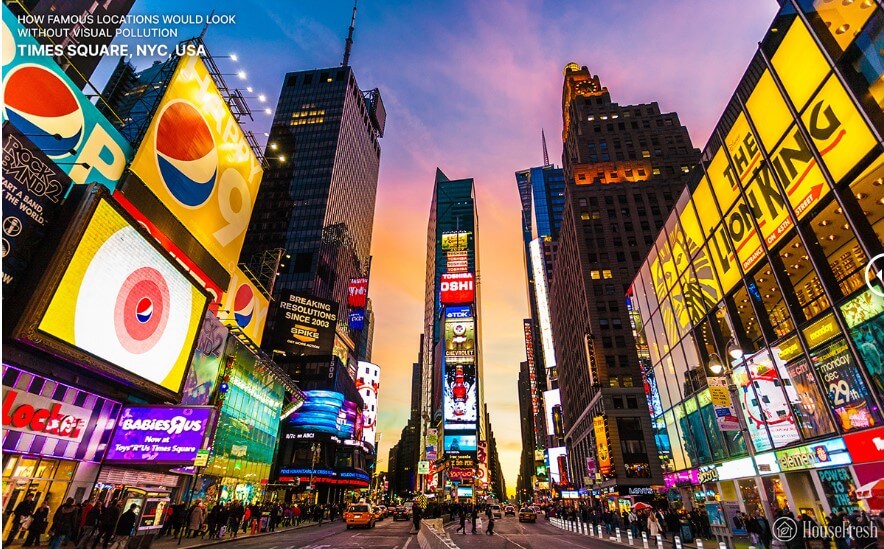 Source: HouseFresh
Source: HouseFresh
Because of its special place in American culture, Times Square is at the center of a debate about whether what one person sees as visual pollution is actually just a natural part of modern life for others. Some people even argue that the old Times Square, with its grime and aging billboards, was actually better because it provided a welcoming backdrop for the city's outcasts. However, the new Times Square is often seen as a symbol of the greed and excess of the 1980s, when it was "Disneyfied." Maybe there's a more thoughtful way we can refresh the visual landscape for the mid-21st century.
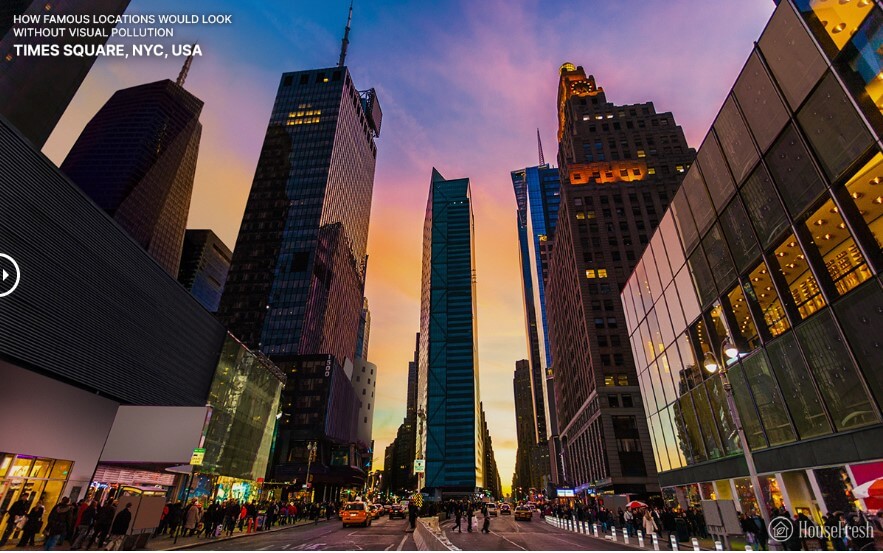 Source: HouseFresh
Source: HouseFresh
#6. Kampala, Uganda
Our before-and-after images of Uganda make us wonder: are cars a form of "visual pollution"? We left them in our pictures because people riding in them are also exposed to the visual pollution in each location. But think about how many times a car has ruined a perfectly good photo or distracted you while walking down a street.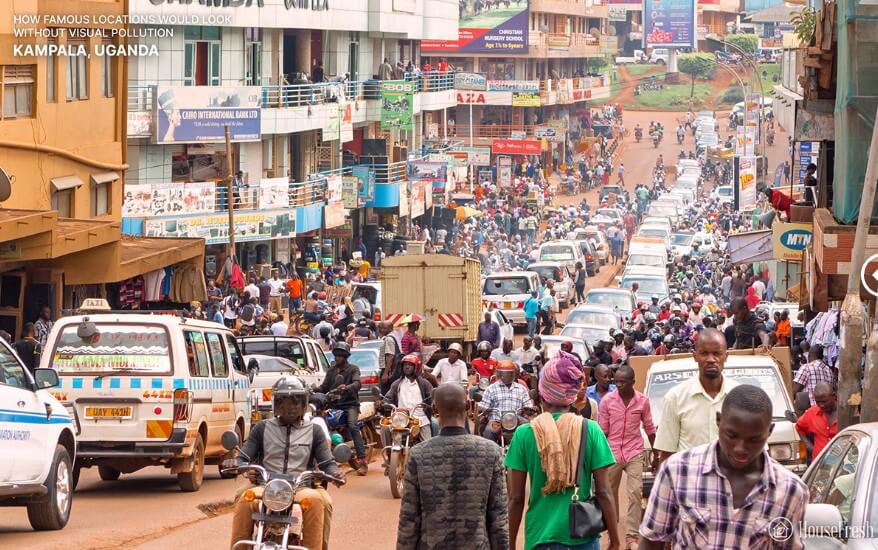 Source: HouseFresh
Source: HouseFresh
Cars are often not very attractive, they can be dirty and distract from the surroundings, which creates more visual pollution, like exhaust fumes, reflections, and extra signs. Thankfully, Kampala is doing something about this problem by addressing visual and air pollution. The city has even been designated as Africa's first "Tree City" for its efforts to plant and protect trees in urban areas.
 Source: HouseFresh
Source: HouseFresh
#7. Las Vegas, USA
It’s hard to imagine Las Vegas without its bright, neon lights, but at what cost? The light pollution in Sin City not only impacts the environment but also affects human health. The bright lights disrupt sleep patterns and can lead to serious health problems such as obesity, heart disease, and even cancer.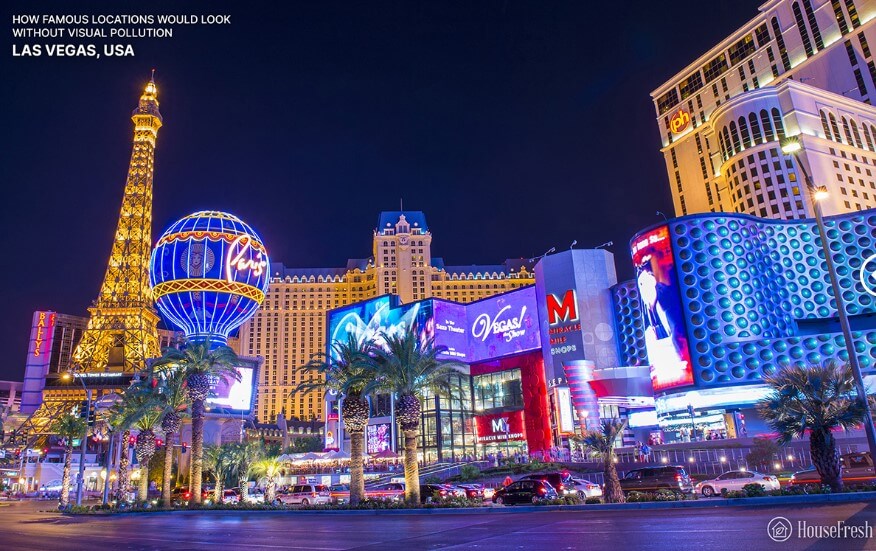 Source: HouseFresh
Source: HouseFresh
A potential solution could be to find a balance between preserving the city's unique identity and reducing the harmful effects of excessive lighting. Perhaps, a more targeted approach to lighting could still create a vibrant atmosphere without negatively impacting human health or the environment.
 Source: HouseFresh
Source: HouseFresh
#8. Piccadilly Circus, London, UK
For over a century, the busy London transport hub has been lit up by illuminated signs, starting with the incandescent bulbs of a Perrier advert in 1908, and later the first neon sign in the 1940s. Back in 1928, The Times newspaper already criticized the use of these signs as they believed it was an eyesore that no civilized community should tolerate, especially in such a prominent location.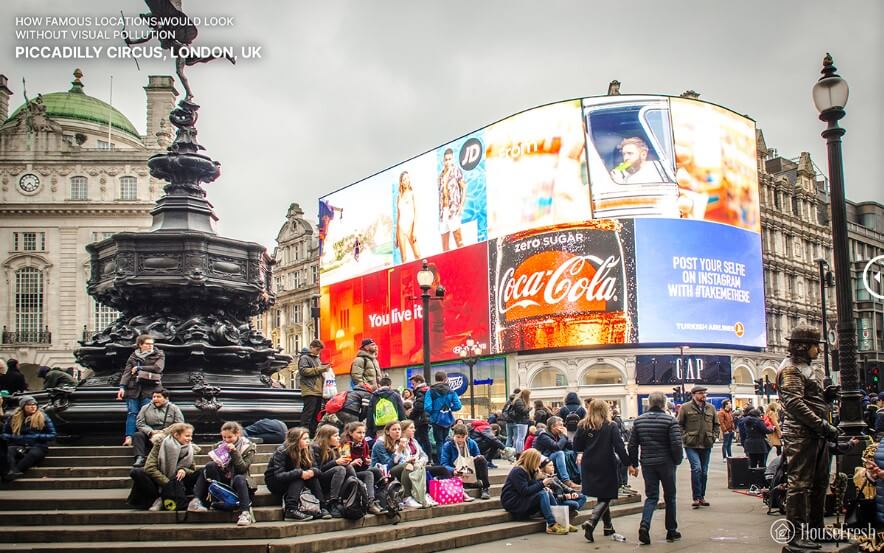 Source: HouseFresh
Source: HouseFresh
Today, there is only one giant sign in the area that has advertising banned from buildings owned by the Crown Estate. Despite this, the area is still known as 'London's Times Square' due to the significance of the location as a junction and entertainment district. The advertising lights were turned off for an hour during the Lights Out London campaign in 2007, but they have only been dimmed during times of war, energy shortages, and national mourning for figures such as Winston Churchill and Diana, Princess of Wales.
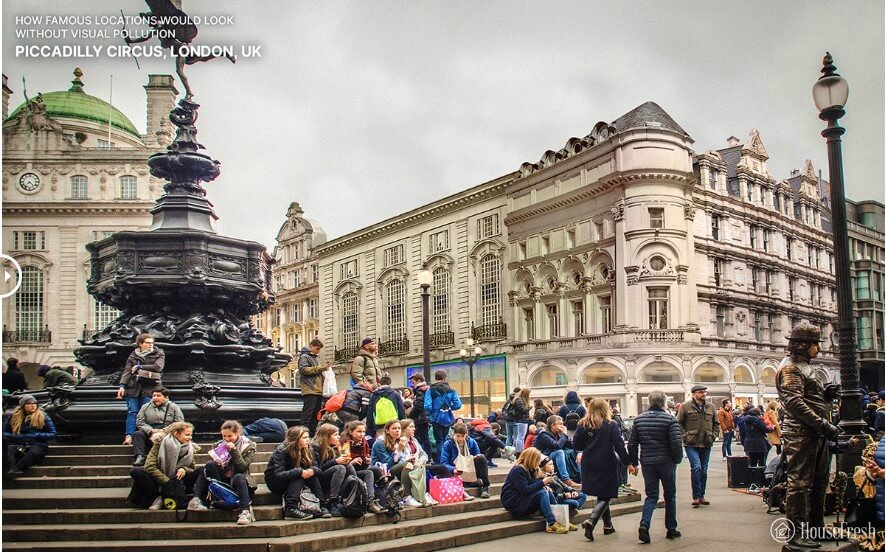 Source: HouseFresh
Source: HouseFresh
Share this article
Advertisement